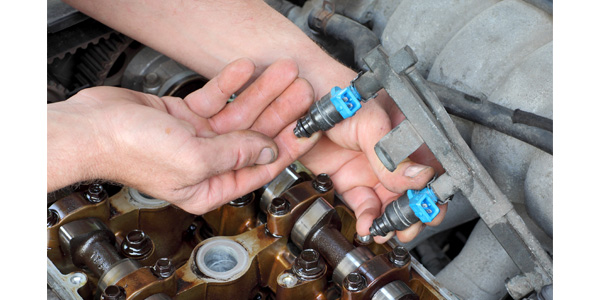
Fuel injection has been the primary system in nearly every production engine made in the past two decades. Fuel injection is more efficient than carburetion, and therefore it also produces fewer tailpipe emissions. But the system is not foolproof. Injector failures run the gamut from bad or faulty mechanicals to dirty, clogged nozzles and leaky seals.
The symptoms of a failing injector might include a misfire due to carbon or dirt that builds up on the tip of the nozzle and affects the spray of fuel into the combustion chamber. The engine also may be difficult to start and have a rough idle. A lean cylinder could lead to detonation or knock and set off a DTC. And finally, performance and fuel economy will suffer if there’s a bad injector in the system.
With proper maintenance, fuel injectors should last the life of the engine. If a customer has failed to perform regular oil and filter changes, it can lead to a slippery slope of engine problems, not the least of which is carbon deposits forming on the injector nozzle because of oil blowing past the piston rings.
If a “Check Engine” light has been illuminated, use an OBD II reader to scan for the cause of the code(s). Most often, a P0300 random-misfire code followed by a specific cylinder code (P0301, P0302, etc.) will be stored in the ECU. Another code that may come up is P0200 for a fuel-injector circuit malfunction. If the voltage is too high or too low, the resistance will drop at the injectors. Codes P0201, P0202, P0203, P0204, P0205, P0206, P0207 and P0208 can be seen alongside other engine-misfire codes, including lean or rich codes.
Some other causes of failed injectors are a broken pintle, ball or disc; a broken return spring; a rusted pintle or ball seat; or a leak in the injector body, typically from an O-ring that’s pinched or broken.
Hydrocarbons and additives found in the fuel supply can gunk up inside the injector and cause it to become restricted. When this happens, the injectors don’t produce optimum flow rates or atomize (spray fuel) the way they should, and can create all sorts of drivability and performance issues.
Technicians typically use an ohmmeter to check the injectors. Too much current flow to an injector may cause the circuit to shut down, killing any other injectors on the same circuit.
There are a few chemicals that can help reduce the carbon inside the micrometer-size orifices to lightly clean, lubricate and maintain a proper spray pattern. In some cases, injectors can be brought back to life by sending them to an injector specialist to be reconditioned, but this depends if your customer can wait that long. More often the case, injectors are replaced with aftermarket units.
The least expensive injectors from mass online retailers may not be up to the quality standards that the majority of shops will want to stand behind. However, most of the well-known aftermarket brands go to great lengths to manufacture replacement injectors to OE specs.







